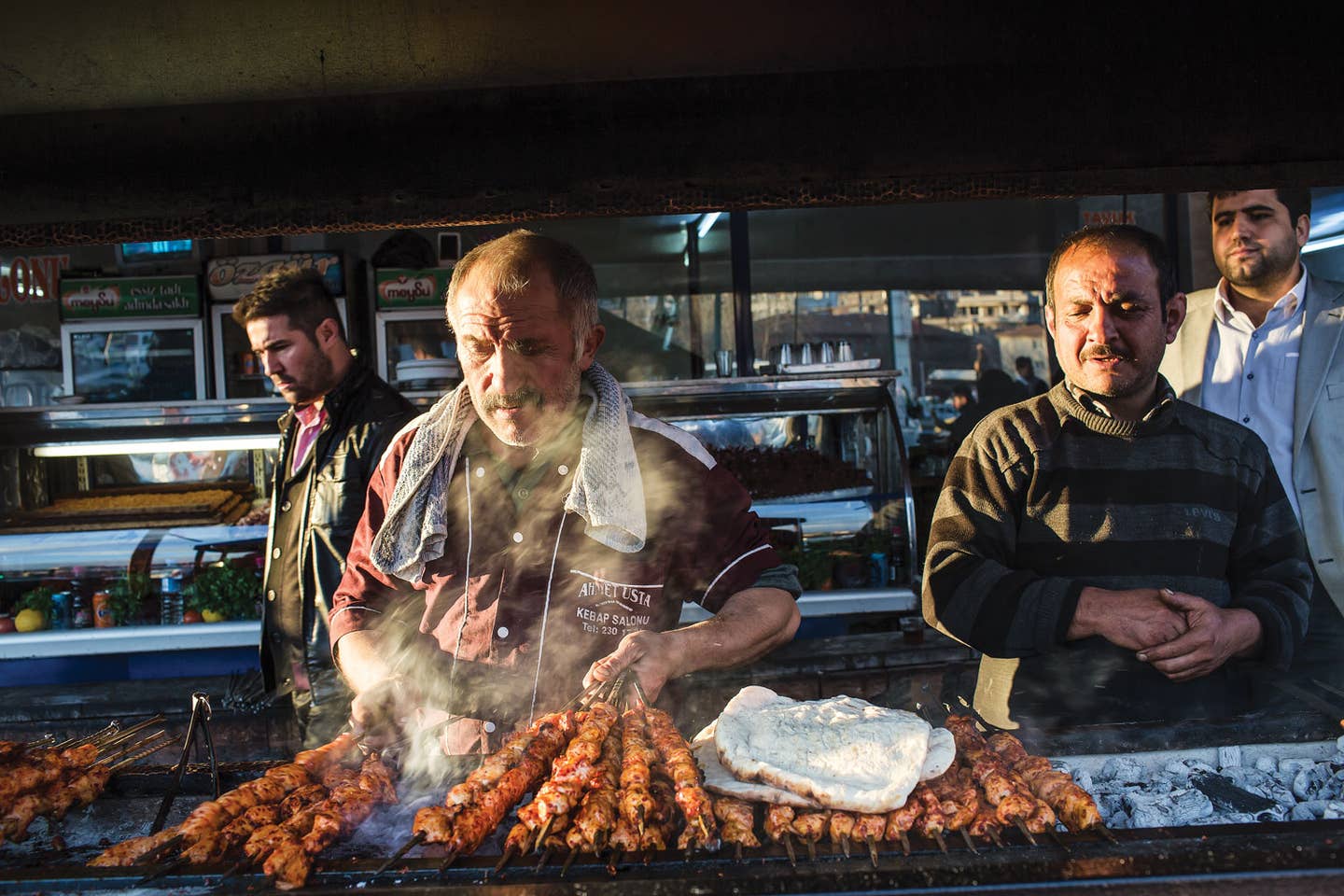
In the vast kitchen of İmam Çağdaş, a kebab restaurant in the southern Turkish city of Gaziantep, Burhan Çadaş, the 51-year-old owner, looked on as his staff of 20 labored in perfect harmony. At one counter, a crew worked ground meat and eggplant onto metal skewers. Another cadre stood at a long grill, deftly rotating skewers of various meats and vegetables over glowing oak charcoal. In a corner, a half dozen men reduced cuts of lamb to a fine crimson paste with scimitar-like blades known as zırh, their rhythmic chopping reverberating like thunder. Hand chopping, explained Burhan, gives his cooks complete control over the texture of the meat, which should hold together on the skewer but crumble under the fork. Besides, he said, "Meat ground by machine has no soul."
I'd come to Gaziantep to learn about the fine art of Turkish kebab making, and İmam Çağdaş was the logical place to start. Burhan is one in the long line of kebap ustas, or kebab masters. An apprenticeship at his almost 130-year-old restaurant is equivalent to an Ivy League degree in Turkish grilling, and the lessons learned on the job reach right back to the hand of the restaurant's namesake, İmam usta, Burhan's grandfather, a legend in the world of Anatolian kebab.
Burhan hovered while a junior usta plated a dish for me to try—an ala nazik kebab of ground lamb on a bed of strained yogurt and smashed roasted eggplant—before drizzling melted butter infused with chiles over the meat himself. I dug in, savoring the spicy, fat-rich lamb, roasted eggplant, and tangy yogurt with every bite. As I ate, Burhan's 73-year-old father, Talat Çağdaş, shuffled past in baggy pants dusted with charcoal, taking in the scene with a nod of approval and saying, "It must be exactly the same as my father made it."
While you can find grilled kebabs all across Turkey, Gaziantep is known for the artistry and ancestry of its ustas, who work from childhood to master every step of kebab making. In this city you'll find ustas grilling everywhere from institutions like İmam Çağdaş to the bustling bare-bones eateries just outside the Kamil Ocak Stadium where people drop in for a quick kebap durumu, skewers of chicken, beef, or lamb wrapped in flatbread. Wherever they are, ustas do more than just grill the meat—they also give each place its heart.
The word usta may be stenciled on nearly every restaurant window in Gaziantep, but a true usta is a rare individual whose hard-earned experience, old-fashioned principles, and humble nature render him an elevated culinarian. His role goes beyond kebab preparation; he is the gatekeeper of tradition. Gaziantep's best ustas are local heroes, the pride of the city.
"It's very hard to be an usta in Gaziantep, because everyone is an usta here!" Sirvan Payasl said, joking about the notoriously finicky and food-crazed locals he serves. He spent 24 years at İmam Çağdaş learning to cook the pantheon of Gaziantep kebabs—soğan kebabı, onion and ground lamb glazed in pomegranate molasses; alti ezmeli, tiny marinated chunks of grilled lamb stewed with tomatoes; and more—before opening his own restaurant, Şirvan Baklava Lahmacun ve Kebab, in 2004.
As we spoke, Payaslı stood before an ornate copper hood with his name etched into it, peeling a dusky brown keme, a prized desert truffle, slices of which he alternated on a skewer with ground lamb and then placed on the grill. Moments later he handed me the result, a beguiling mix of smoky meat and tender, nutty truffle, a rarity even in Gaziantep, where, depending on the season, ustas might work quince or loquats onto their kebabs, and flavor the ground lamb with chopped tomatoes or pistachios.
Away from these famous kitchens, in the backstreets there are humble grill joints that are just as beloved. At six o'clock one morning, at the insistence of a taxi driver, I visited a tiny smoke-filled shop called Ciğerci Ali Haydar Usta, just as the morning prayer crowd descended from the mosque across the street. Having selected prepared skewers from a pushcart out front, men jostled giddily around the usta as he laid the food on the grill inside, taking part in a local ritual: a breakfast of cubed lamb liver kebab served on flatbread with chopped parsley, raw onions, tart sumac, and a spritz of lemon. By 8 a.m. the gregarious usta, Mehmet Ali Gurbuz, was sold out.
"I wear my customers like a crown; this relationship gives my life meaning," he told me. Then he closed up shop and headed to the market to buy the next day's liver, as he's done for the past 45 years and as his father did before him. —Ansel Mullins, co-author of Istanbul Eats (Boyut, 2010)
Keep Reading
Continue to Next Story










